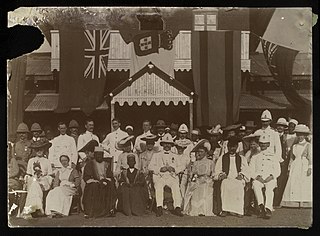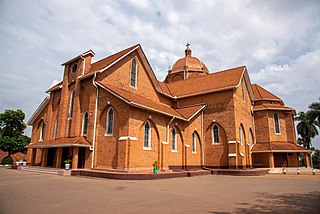
Kampala is the capital and largest city of Uganda. The city proper has a population of 1,680,000 and is divided into the five political divisions of Kampala Central Division, Kawempe Division, Makindye Division, Nakawa Division, and Rubaga Division.

Danieri Basammula-Ekkere Mwanga II Mukasa was the 31st Kabaka of Buganda who ruled from 1884 until 1888 and from 1889 until 1897.

The Church of Uganda is a member province of the Anglican Communion. Currently there are 37 dioceses which make up the Church of Uganda, each headed by a bishop.
The Anglican dioceses of Buganda are the Anglican presence in the Central Region, Uganda ; they are part of the Church of Uganda. The remaining dioceses of the Church are in the areas of Eastern Uganda, of Northern Uganda, of Ankole and Kigezi, and of Rwenzori.

The Archdiocese of Kampala is the Metropolitan See for the Roman Catholic Ecclesiastical province of Kampala in Uganda.
St. Lawrence University is a private university in Kampala, Uganda.
Mengo is a hill in Rubaga Division, Kampala, Uganda's capital and largest city. The name also applies to the neighborhood on that hill.
Lubaga is a hill in Kampala, Uganda's capital and largest city. It comes from the Luganda word okubaga, describing a process of "planning" or "strengthening" a structure while constructing it. For example, okubaga ekisenge means to strengthen the internal structure of a wall while building a house. The name also applies to the neighborhood on the hill.
Rubaga Division, also Lubaga Division, is one of the divisions that makes up the city of Kampala, Uganda. The division takes its name from Rubaga, where the division headquarters are located.
Prince Daudi Kintu Wasajja also called David Wasajja is a prince of Buganda, the largest traditional kingdom in Uganda.
Namirembe is a hill in Kampala, Uganda's capital and largest city. It is also a common name given to girls in several Baganda clans. Namirembe comes from the Luganda word "mirembe" meaning peace. Namirembe loosely translates into Full of Peace. Legend has it that this hill was a gathering place for celebrating peace or war victories.
Banda is a hill that lies in Nakawa Division, within Kampala, the capital of Uganda. Banda also refers to the neighborhoods on the slopes of the hill and between Banda Hill and Kireka, extending all the way to the Kampala-Jinja Highway. The southwestern slopes of the hill are occupied by the neighbourhood known as Kyambogo, and is the location of the campus of Kyambogo University, one of the nine public universities in the country.

Mengo Hospital, also known as Namirembe Hospital, is a private, faith-based, community, teaching hospital in Kampala, the capital and largest city of Uganda.
Uganda Martyrs' Hospital Lubaga, commonly known as Lubaga Hospital, which was formerly named Rubaga Hospital, is a private, not-for-profit, community hospital in Kampala, the capital city of Uganda.

The Bulange (boo-lah-ngeh) is a building in Uganda. It houses the Lukiiko (Parliament) of the Kingdom of Buganda. The Kabaka of Buganda and the Katikkiro of Buganda also maintain offices in the building. The building serves as the administrative headquarters of the Buganda Kingdom.

Football is the national sport in Uganda. The Uganda national football team, nicknamed The Cranes, is the national team of Uganda and is controlled by the Federation of Uganda Football Associations. They have never qualified for the FIFA World Cup; their best finish in the African Nations Cup was second in 1978.
Mengo Senior School, also known as Mengo SS, is a comprehensive, mixed day school in Kampala. As of March 2020, it had over 5300 students, 250 teachers, 28 technical staff, and more than 30 support staff.

Saint Paul's Cathedral Namirembe, commonly referred to as Namirembe Cathedral, is the oldest cathedral in Uganda. It serves as the provincial cathedral of the Anglican Church of Uganda and the diocesan cathedral for Namirembe Diocese, the first diocese to be founded in the Church of Uganda province, in 1890. Between 1919 and 1967, the Cathedral served as the provincial cathedral of the Church of Uganda, Anglican Communion. In the 1960s, the headquarters of the Church of Uganda moved to All Saints Church in Nakasero then moved back to Namirembe later.
The pioneer White Fathers were affliated to the Catholic Missionary Society of White Fathers which is also known as Religious Institute of the Missionaries of Africa. They arrived in Algiers in February 1874. They started their journey to the Equatorial Africa on the 15th November 1878. They spent a total of 10 months on their journey that is 2 months in a boat from Algiers to Bagamoyo and the other 8 months on foot from Bagamoyo to Kigungu.

Mapeera Church alias was the first constructed catholic church in Uganda in 1879 by the White Fathers. It is located in Lusaze Lubya in Nabulagala, Kigungu Landing site behind Entebbe Airport in Uganda.










